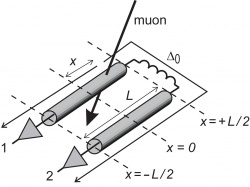Twin Tubes
What are Twin Tubes?
The precision measurements of muons in ATLAS are done by Monitored Drift Tubes (MDT's). The whole muon spectrometer will reach precision smaller than 80 in the bending direction of the magnetic field. Many corrections need to be done to get the actual drift-time from measured signals. The correction for the delay due to the signal propagation along the tube turns out to be one of the larger corrections. The longer the signal has to travel along the wire the larger the correction, so outer chambers particularly 5m-long BOL's need precise measurement of the hit position along the tube. In the original design of ATLAS the position of the hit along the tube is measured by trigger chambers (RPC's). However the twin tube concept enables us to measure the propagation correction using MDTs themselves.
Operating Principle
Two MDTs are interconnected at the high voltage (HV) end via an impedance matched jumper. Consequently the tubes are read-out at both ends. A muon hitting an MDT not only creates a signal in the hit tube but as well a signal in its twin partner. The time difference between these two signal is used to calculate the propagation correction.
For further details on the concept and performance reader is refered here

